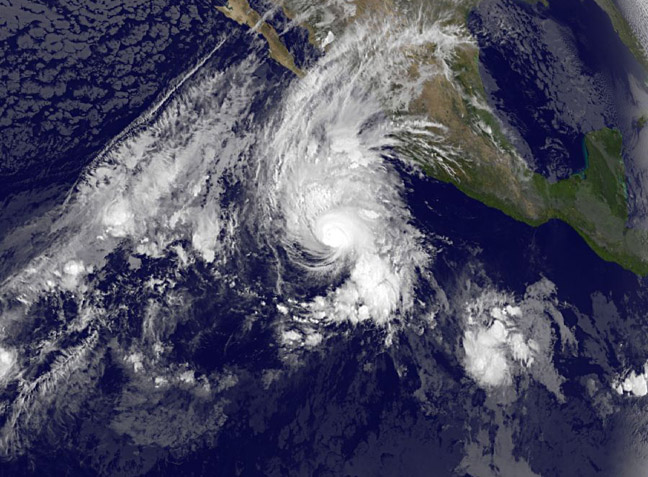Hurricane Vance Dwarfs Developing Low Pressure Area

NOAA's GOES-West satellite captured an image of Hurricane Vance and a developing low pressure area CALLED System 94E, southeast of the hurricane. Image Credit: NASA/NOAA GOES Project
NOAA's GOES-West satellite captured an infrared image of the Eastern Pacific that showed Hurricane Vance was a couple of times larger than the developing low pressure area known as System 94E to the southeast of the hurricane. In the GOES image, taken Nov. 3 at 1200 UTC (7 a.m. EST/4 a.m. PST) clouds and showers extending from Vance's northern quadrant stretched over northwestern Mexico.
At 7 a.m. PST, the center of Hurricane Vance was located near latitude 15.3 north and longitude 110.6 west. That puts Vance's center about 490 miles (785 km) west-southwest of Manzanillo, Mexico. Vance was moving toward the north-northwest near 12 mph (19 kph). Vance is expected to turn north then north-northeast by Nov. 4. Maximum sustained winds were near 105 mph (165 kph) and weakening is expected to begin today.
Moisture spreading northward ahead of Vance is expected to produce rainfall totals of 4 to 8 inches with Isolated amounts near 12 inches through Wednesday over the states of Sinaloa, Nayarit and Durango in western Mexico. Rough ocean swells are expected along the coast of southwestern Mexico and Baja California Sur tonight and Nov. 4.
Forecaster Brown at the National Hurricane Center (NHC) noted that “Recent microwave images show that the inner core of Vance remains vertically aligned (stacked on top of each other), however, the outflow is becoming increasingly restricted over the southwestern portion of the circulation due to southwesterly shear.” That vertical wind shear over Vance is forecast to dramatically increase during the next 24 to 48 hours which means that the storm is expected to weaken.
The NHC believes that Vance has peaked in intensity and will begin to rapidly weaken in the next couple of days as it curves to the coast near the border of Mexico and California.
Rob Gutro
NASA's Goddard Space Flight Center
Media Contact
All latest news from the category: Physics and Astronomy
This area deals with the fundamental laws and building blocks of nature and how they interact, the properties and the behavior of matter, and research into space and time and their structures.
innovations-report provides in-depth reports and articles on subjects such as astrophysics, laser technologies, nuclear, quantum, particle and solid-state physics, nanotechnologies, planetary research and findings (Mars, Venus) and developments related to the Hubble Telescope.
Newest articles

Trotting robots reveal emergence of animal gait transitions
A four-legged robot trained with machine learning by EPFL researchers has learned to avoid falls by spontaneously switching between walking, trotting, and pronking – a milestone for roboticists as well…

Innovation promises to prevent power pole-top fires
Engineers in Australia have found a new way to make power-pole insulators resistant to fire and electrical sparking, promising to prevent dangerous pole-top fires and reduce blackouts. Pole-top fires pose…

Possible alternative to antibiotics produced by bacteria
Antibacterial substance from staphylococci discovered with new mechanism of action against natural competitors. Many bacteria produce substances to gain an advantage over competitors in their highly competitive natural environment. Researchers…





















